Resources
https://www.wabashcenter.wabash.edu/journal/
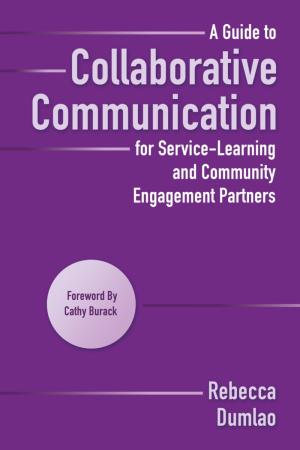
This book focuses on partnerships at the most basic level of interaction – between two people as they work toward common goals. Interpersonal dynamics described in this book are intended to guide formal and institutional relationships between members of a community or community organization on the one hand and representatives from campus on the other. Collaborative communication principles and practices shared can form a foundation for individuals to build flexible, lasting relationships that will weather most challenges and sustain the larger partnerships of their respective organizations. This book offers a conceptual framework of collaborative communication to build and sustain partnerships, recognizing that relationships change over time as the people involved and their circumstances evolve. Collaborative communication uses a repertoire of knowledge and skills that allow partners to make choices that fit their situation or context and to work through differences and challenges as they occur, to include managing conflict and navigating cultural differences. It further takes into account the different means of communication, whether face-to-face, using e-mail, text messaging, or social media. Readers will appreciate the numerous real world examples that illustrate and bring its key concepts to life. This book is addressed to partners at all levels focused on community engagement and service-learning. It is intended for preparing college students to work more effectively in the community, as well as for workshops for community and campus members who work with service-learning students. It can equally be used in leadership workshops in academic and community settings. Scholars, students, or community members involved in community engaged research will also find useable ideas for their work. The appendices offer an annotated bibliography of useful resources and provide readers with a repertoire of activities for building a collaborative communication repertoire. (From the Publisher)
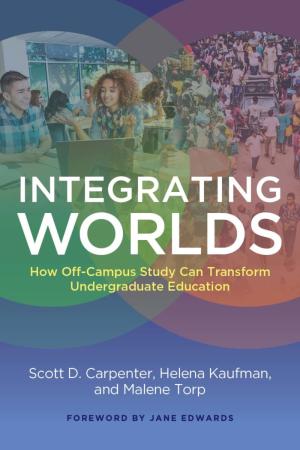
What if our students learn the most when they’re far from campus? Integrating Worlds demonstrates how high-quality off-campus study epitomizes integrative learning, both supporting and enhancing the entire undergraduate experience. While off-campus study (both study abroad or study away) occupies a marginal position on most campuses, it has the almost unique capacity to bring together a high concentration of high-impact educational practices. When we combine global learning with collaborative work, shared intellectual pursuits, learning communities, and more, these practices reinforce each other, exerting a multiplier effect that can potentially result in the most intense learning experience our students will have. It can energize and inspire them for the work they will continue to undertake on their home campus. It thus becomes crucial for us to identify or design high-quality programs that will achieve these goals. Moreover, we need to reimagine off-campus study as an integrated portion of the undergraduate arc—one that begins well before our students depart and continues long after they return. In this way, we help them understand the interconnectedness not only of the world, but also of their own education. At the same time, the authors recognize material constraints and educational imperatives. Off-campus study costs money; its complexity makes it difficult to assess; it overlaps increasingly with internships and civic engagement; and by its nature, it is more subject to external forces than the on-campus experience. In careful, practical ways Integrating Worlds advances suggestions for dealing with these issues. This book urges educators to go beyond the episodic ways we currently link on-campus curricula to off-campus experience. While of interest to specialists in international or intercultural education, it speaks most directly to faculty, deans and provosts—many of whom may have little (or dated) experience of study abroad and who thus feel unprepared to address this issue of pressing importance. As our disciplines and institutions face the complexities of a rapidly changing world, this book seeks to fuel the necessary conversations. (From the Publisher)
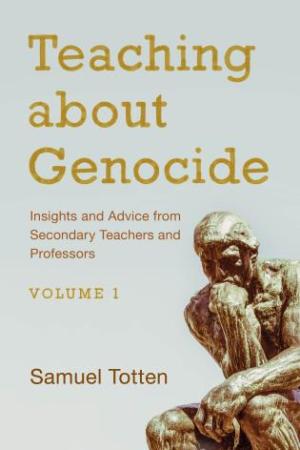
Secondary level teachers and professors from various disciplines present their best advice and insights into teaching about various facets of genocide and/or delineate actual lessons they have taught that have been particularly successful with their students. (From the Publisher)
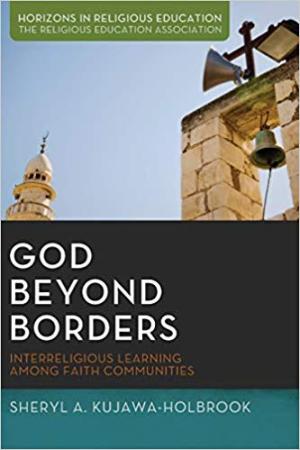
Based on ten years of research, God Beyond Borders is a comprehensive study of interreligious learning in faith communities. The United States is one of the most a diverse countries of the world. Kujawa-Holbrook details the many practices of interreligious learning in faith communities; through interreligious encounters, religious education, shared sacred space, shared prayer, and compassionate action. The book also surveys the field of interreligious learning and investigates some of the more common intentionally interreligious communities--families, clergy groups, chaplaincies, and community organizations. Kujawa-Holbrook combines theory and praxis to make a case for the importance of interreligious learning in all religious organizations. (From the Publisher)
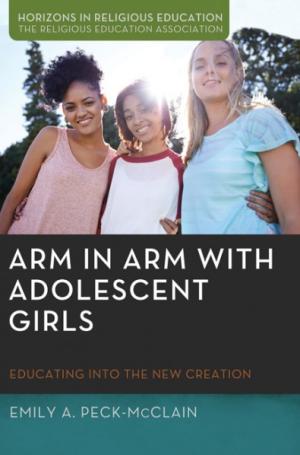
Adolescent girls are filled with passion, excitement, joy, critique, wit, and energy, even as they face and overcome a wide variety of difficult challenges. Some challenges are spirit- and even life-threatening. The stories of more than twenty adolescent girls are put into dialogue with the Apostle Paul, especially in Rom 6–8. Through that perhaps unlikely pairing, those who love and work with adolescent girls will find a depth of understanding and a call to action. Christian educators, pastors, youth workers, parents, and adolescent girls will find a new way to look at the world around them and a new way to bring Scripture to bear on real-life experience. By offering this powerful, scripturally-grounded approach to the world around us, adolescent girls and others will learn compelling methods for putting a new perspective into action in their personal lives, social circles, and churches. This thoughtful and respectful look at the lives of adolescent girls seeks to equip faithful Christians in the church to use their prophetic voices to call out the sins of racism, sexism, homophobia, and sizeism in the experiences of these strong and resilient girls. (From the Publisher.)
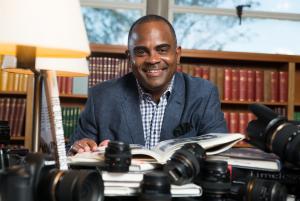
I learned something this holiday season—my first holiday season as a grandfather. My family traveled from Atlanta, Georgia to Orlando, Florida to surprise my mother, Mrs. Earlene Watkins, on her 80th birthday. The surprise is summed up in this moment. [caption id="attachment_239279" align="aligncenter" width="397"] Mrs. Earlene Watkins, My Mother[/caption] My mother didn’t know that that I was coming with my wife. But, we weren’t the big surprise. The big surprise was the new addition to our family. Her new, four-month old, great-grandson, Princeton Josiah Smith. My daughter, Nicole Smith, and her husband, Walter Smith, conspired with us to make this day possible! My daughter Nastasia Watkins and I both videotaped this historic moment. I shot with two cameras: I walked in using my Canon G7 Mark II, and then I shot with my Canon EOS C100. These two cameras are what I am most comfortable with. I had to bring them in large camera bags, set them up, and prepare to shoot. In contrast, my thirty-two-year old daughter, Nastasia Watkins, shot her video with the camera she lives with: her iPhone. She not only shot this video with her phone, but she also edited the video on her phone. She posted her video within minutes. I took my video back to the hotel, edited it on my laptop in Final Cut X, and posted my video on the next day! [caption id="attachment_239281" align="aligncenter" width="392"] My Mother, My Daughter, My Son-in-law and Princeton Josiah Smith[/caption] What did I learn? Nastasia Watkins is no teenager. My daughter is a partner in her own law firm. She and her peers are completely comfortable making memories with what is in their hands. As I watched her shoot video and take pictures over the holidays, it was clear that she was always ready to shoot. On the other hand, it was more work for me. It didn’t come naturally. I didn’t use my phone. I had to go get my camera, get ready, shoot, and then put the camera down. My daughter never put her camera down. It was no challenge for her to be engaged in the moment and shoot simultaneously. I was wowed by her ability to be fully present and to capture the moment. She taught me how her peers and those coming up behind her are processing, capturing, and seeing their world. They see the world with phone in hand. Their phone is not used to make phone calls, but as a way to see, engage, make sense of, understand, and frame their world. For we teachers, these are our students. They see their world through a screen the size of their phones. If we are to understand how to engage them, we must see what they see, how they see, and how they learn to make sense of that which they engage. How do we do this? We must pick our phones up and start to use them as they use them. I have to put my big, expensive cameras down. I am recommitting myself to using my iPhone X for the reason I say I bought it: for the camera. When you see commercials about the latest phone, they never advertise the phone’s ability to make phone calls. They sell the phone as a camera. It was the commercial that sold me, and after this holiday season I have recommitted to using the most powerful pedagogical tool I have with me all the time and that is the camera on my phone. When we use the phone as a camera and editing device, we will begin to engage and make sense of the world our students live in. This will, in turn, inform our teaching and learning. We will see the phone as a teaching and learning device and not as a distraction from our traditional teaching moments. When we see the tool in our hand as a revolutionary pedagogical device, it will change how we use that which we have in our hand. [caption id="attachment_239282" align="aligncenter" width="408"] The Family at the Surprise Birthday Party for Mrs. Earlene Watkins @ 80![/caption] Well, I know you want to see the two videos . . . here you go! Video by Nastasia Watkins https://vimeo.com/382453975 Video by Ralph Watkins https://vimeo.com/382456567 Photo credit: Victor Watkins
[row] [column lg="12" md="12" sm="12" xs="12" ] [su_heading]This information is for participants already accepted into the workshop.[/su_heading] [/column] [/row] [row] [column lg="4" md="4" sm="12" xs="12" ] [su_button url=" https://www.wabashcenter.wabash.edu/programs/workshops/2019-20-wabash-colloquy/" background="#86b53e" size="3" wide="yes" center="yes" radius="5" text_shadow="0px 0px 0px #FFF" desc="Participants, Other Dates, etc..."]View Info About This Workshop[/su_button] [/column] [column lg="4" md="4" sm="12" xs="12" ] [su_button url=" https://www.wabashcenter.wabash.edu/programs/workshops/winte-workshop-accommodations/" background="#86b53e" size="3" wide="yes" center="yes" radius="5" text_shadow="0px 0px 0px #FFF" desc="Flights, Lodging, Directions, etc..."]Info on Food, Travel and Accommodations[/su_button] [/column] [column lg="4" md="4" sm="12" xs="12" ] [su_button url="https://www.wabashcenter.wabash.edu/programs/workshops-home/policy-on-full-participation/" background="#86b53e" size="3" wide="yes" center="yes" radius="5" text_shadow="0px 0px 0px #FFF" desc="Attendance, Guests, Dependent Children, etc..."]View Our Policy on Full Participation[/su_button] [/column] [/row] [row] [column lg="12" md="12" sm="12" xs="12" ] Ground Transportation About a week prior to your travel you will receive an email from Beth Reffett (reffettb@wabash.edu) with airport shuttle information (pdf). This email includes the cell phone number of your driver, where to meet, and fellow participants with arrival times. Please print off these instructions and carry them with you. [/column] [/row]
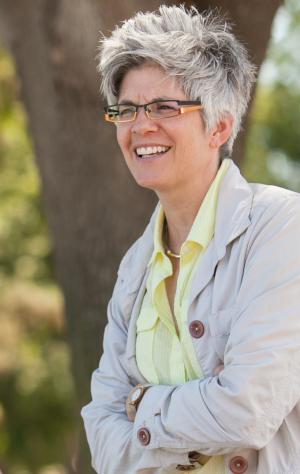
Introduction to the Series The cinema has become an important means of cultural communication, a contemporary language in need of understanding and explication . . . Some even believe that cinema studies is positioned to become the new MBA, a means of general preparation for careers in fields as diverse as law and the military.[1] Although multimedia literacy is not one of the accreditation standards for theological schools (yet!), add theological studies to the diverse fields mentioned in the quote above. As seminary education continues to follow the higher education trend toward online teaching and learning, instructors are recognizing the need to enhance their multimedia literacy. Minimally, it is important to note that many of our students are already literate in the contemporary language of cinema. Many students would agree with the following: Movies serve not simply as a commodity but as a primary storytelling medium of the twenty-first century, interpreting reality for us, providing us with a common language, and acting as a type of cultural glue.[2] For many, “image” has replaced “text” as the central tool of communication. This substitution challenges theology’s centrality of the Word (text) and revives a longstanding love/hate relationship between the pious and images. The obstacles are especially palpable for an oral/aural ecclesial practice like preaching. After all, faith comes through hearing (Romans 10:17), not seeing, right? Despite such challenges, the Reformation spirit asks us theologians to embrace new means of communicating the gospel. Cinematic competency seems to be today’s printing press. So, in an attempt to meet students where they are (and teach others along the way), I’ve tried to boost my multimedia literacy by becoming a student of the cinema and seeking convergences between filmmaking and homiletics for the purposes of enlivening the preached word, communicating the gospel, and impacting hearers and their/our world. Part 1: Nobody Goes to the Cinema to Read the Screenplay Despite numerous obvious differences between the two fields that might render them too dissimilar for comparison (for example, films take years to produce and preachers generally have to squeeze sermon preparation into 6 busy days; films are primarily visual experiences, sermons are primarily aural experiences), preachers have much to learn from filmmakers. In this 4-part blog series, I will propose elements, concepts, and techniques from filmmaking that can serve preachers. We begin with this week’s reminder: Nobody goes to the cinema to read the screenplay . . . or even to hear it read. In the same way, nobody goes to worship to read a written sermon . . . or even watch the preacher read it. Oh, yes, people in the pews have become accustomed to the latter, but they should expect more from us preachers. You see preaching is inevitably a kind of performance. These two “p” words are often considered to be at odds since preaching is not solely for entertainment or to heighten the performers ego (to be sure, performers in a variety of arts, including film, expect their performances to move beyond these two outcomes as well). However, preaching is a performance in that it “completes, carries out, accomplishes” something, as its Old French etymology suggests (par-fournir). Indeed, preaching brings an experience to life. T.S. Eliot noted that “Literature was turning blood into ink.” Preaching, on the other hand, turns ink (the written biblical text) into blood; that is, it intends to bring the sacred text to life. Therefore, a sermon is a road map or a blue print for a transformational experience. “Road map” and “blueprint” are often used for screenplays as well. Preachers would do well to consider the following analogy from a screenwriter. However brilliant, [a screenplay is] always in a state of becoming, forever on the way to being something else—a film. You can admire a cocoon for its marriage of function and form, but ultimately it’s the butterfly that will make its way in the world.[3] Or, as another puts it, “. . . screenplays don’t really exist until they’re made into movies.”[4] In the same way, one might consider that a written sermon doesn’t really exist until it’s preached. So, how does this connection to the digital world guide the teaching of preaching? First and foremost, simply making the analogy explicit quickly resonates with preachers-to-be. Therefore, students are challenged to make their “scripts” (yes, I call them scripts) a means to an end, and not the ends themselves. Sermons that pay attention to sermon delivery from the beginning of the writing/crafting process tend to create more of an experience for and with the listeners. Such preaching has more of a chance to turn ink into blood and “make its way in the world.” [1] Robert K. Johnston, Craig Detweiler, and Kutter Callaway. Deep Focus: Film and Theology in Dialogue, 11. [2] Deep Focus, 10. [3] Dan Gurskis. The Short Screenplay: Your Short Film from Concept to Production (Aspiring Filmmaker's Library), Kindle Edition, xii. [4] Joel Engel, Oscar-Winning Screenwriters on Screenwriting (New York: Hyperion), 2.
Wabash Center Staff Contact
Sarah Farmer, Ph.D
Associate Director
Wabash Center
farmers@wabash.edu